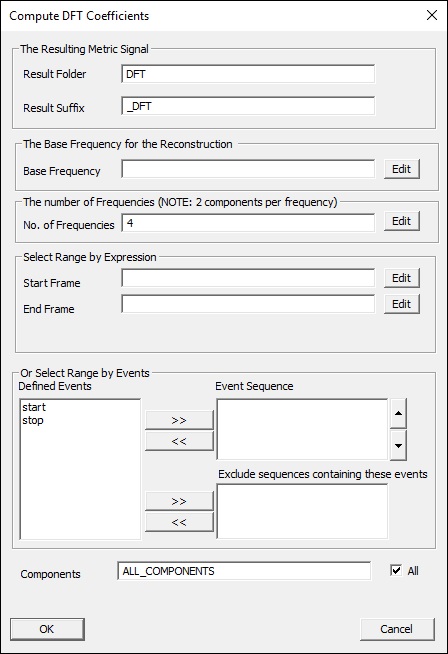Metric Compute DFT Coefficients
The Discrete Fourier Transform of a Signal
This command computes a metric signal containing the DFT coefficients and the Base Frequency.
The form of the DFT is as follows:
p(t)= p0 + p1 sin(w t) + p2 cos(w t) + p3 sin(2w t) + p4 cos(2 w t) + ….
where w = 2 * PI * Base_Frequency
The distinct difference between a DFT and an FFT is that the DFT allows the user the option to specify the base frequency.
This is useful if you want to compare the coefficients across trials and/or across subjects. It also means that the base frequency has physical meaning, such as stride frequency.
See also Compute Power from DFT coefficients
Pipeline Command
Metric_Compute_DFT_Coefficients /SIGNAL_TYPES= ! /SIGNAL_NAMES= ! /SIGNAL_FOLDER=ORIGINAL ! /SIGNAL_COMPONENTS=ALL_COMPONENTS ! /RESULT_SUFFIX=_DFT ! /RESULT_FOLDER=DFT ! /EVENT_SEQUENCE= ! /EXCLUDE_EVENTS= ! /START_FRAME= ! /END_FRAME= ! /USE_POINT_RATE=TRUE ! /BASE_FREQUENCY= /NUM_FREQUENCIES=4 ;
Signal_Components
Each component of the signal will generate a metric signal containing the coefficients for that component of the signal.
Number of Frequencies
The parameter Num_Frequencies determines the number of coefficients that will be stored in the resulting metric signal.
If Num_Frequencies is empty, the number is determined consistent with a standard DFT or FFT.
Num_Frequencies = 1 + NumFrames/2
where the Maximum Number of Frequencies = 0.5*DataRate;
Event_Sequence
The Event Sequence and Exclude_Sequence define the range of frames used to compute the DFT coefficients
Base_Frequency
If BASE_FREQUENCY is empty,
Frequency= SamplingRate/NumberOfFrames (average per cycle per file) Else
Frequency= Numerical value or Expression
Resulting Metric Signal
The metric signal is stored as follows (Base_Frequency, p0, p1, p2, p3, p4, ….)
The Base_Frequency and coefficients are stored as components of the signal.
If there are multiple ranges of data, there will be a “frame” or “row” for each range.
see also : Metric_Compute_Power_From_DFT_Coefficients

